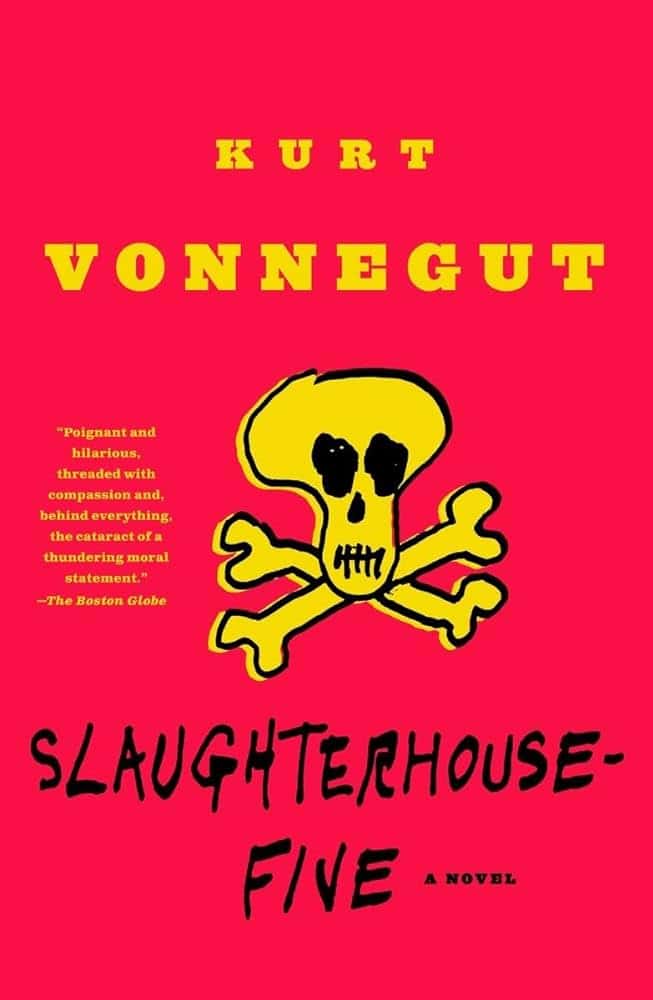Kurt Vonnegut’s Best Science Fictional Creations
The author would have turned 85 this week.

Kurt Vonnegut often wrote science fiction, but you don’t often hear him described as a “science fiction writer.” That’s because many of his works, even those packed with science fictional ideas, won widespread critical praise as “Literature” in a time when science fiction was often dismissed as kid’s stuff, somehow less worthy of examination than more mainstream fare.
But however you care to label him, Kurt Vonnegut’s wondrous imagination spun stories unlike anyone else’s, tackling science fiction notions such as time travel and using them to examine concepts such as free will with great insight and a pitch-black sense of humor.
Kurt Vonnegut passed away in 2007, but his legacy lives on. And unlike some ivory towers out there, we here at GFR are all about science fiction, so we decided to celebrate some of Vonnegut’s most interesting SF ideas. “All of this happened, more or less…”

The Sirens of Titan
We could have easily made a list of “Kurt Vonnegut’s Best Science Fiction Books,” but instead, we wanted to zero in on some of the specific ideas and creations he served up over the years. I think Vonnegut would have appreciated that we’re beginning this list by immediately doing the thing I just said we wouldn’t do.
While The Sirens of Titan has all manner of crazy SF ideas packed into it, the book is uniquely fascinating for a couple of reasons. Only Vonnegut’s second published novel, Sirens is unabashedly science fiction: it involves aliens, robots, interplanetary war, seeing into the past and future, and assorted jaunts around the solar system.
It’s crazy, frequently funny, and, because it’s Vonnegut, all the genre trappings are draped over a narrative that reflects his own fatalistic thoughts about life and death.
Sirens plays like a sort of retelling of the Bible, all dressed up in space clothes. Unsurprisingly, given his history of tragedy — his mother’s suicide and the deaths of his brother-in-law and sister, only two days apart — Vonnegut had a few strong opinions about god, religion, free will, and the rest. His view of a random and apathetic universe is on display throughout Sirens, which, among other things, introduces the Church of God the Utterly Indifferent. (“I was a victim of a series of accidents, as are we all.”)
If that sounds very much like a Douglas Adams kind of idea, that comparison comes naturally — Adams cited Sirens as a major influence on his Hitchhiker’s Guide to the Galaxy books. Even if Sirens isn’t Vonnegut’s best work, that legacy alone would make it a shoe-in for this list.
Mankind flung its advance agents ever outward, ever outward. Eventually it flung them out into space, into the colorless, tasteless, weightless sea of outwardness without end.
It flung them like stones.
― Kurt Vonnegut, The Sirens of Titan

Becoming Unstuck in Time
Time is a subject Vonnegut returned to over and over in his career, most famously with his best-known work, Slaughterhouse-Five.
But even if you weren’t forced to read the book in middle school, it shouldn’t surprise you to learn that Vonnegut’s vision of time travel is a long way from the antics of Marty McFly, or even the “set right what once went wrong” of Quantum Leap’s Sam Beckett. As with the latter, Slaughterhouse-Five protagonist Billy Pilgrim has no control over where or when he will find himself at any given moment, slipping back and forth along his own timeline at the whim of a capricious universe.
Pilgrim gains perspective on this process from the alien Tralfamadorians, who kidnap him and keep him in a zoo for a time. The Tralfamadorians can see all of time simultaneously, beginning to end, but are not bothered by the larger implications of that. Namely, if you can see everything that has or will happen, does the concept of “free will” mean anything at all?
Vonnegut returned to the concept of time travel in a big way with his last published novel, 1997’s Timequake. It takes a classic sci-fi notion — traveling back and getting to relive your past — and puts a thoroughly Vonnegut spin on it. In the book, everyone living in 2011 suddenly finds their consciousness ripped back to 1991.
From there, they get to re-experience those 10 years, but they can’t change anything. In fact, they’re little more than helpless spectators, riding inside their younger bodies as they go through the motions of a decade’s worth of already-lived history. There are many time travel stories that posit similar notions of fruitless time travel — Twelve Monkeys, for one — but you’d be hard-pressed to find a less enticing version than in Timequake.
‘All time is all time. It does not change. It does not lend itself to warnings or explanations. It simply is. Take it moment by moment, and you will find that we are all, as I’ve said before, bugs in amber.’
– Kurt Vonnegut, Slaughterhouse-Five

Ice-nine
The deceptively simple name “Ice-nine” does little to suggest just how dangerous this theoretical substance could be. Serving as a major plot point in Cat’s Cradle, Ice-nine is a form of water that is solid at room temperature.
To melt it, you have to heat it up to 114.4 degrees Fahrenheit. That might sound great for that ice sculpture you commissioned for your next birthday, but there’s just one problem: ice-nine is almost a virus of sorts — any regular water it comes into contact with automatically becomes ice-nine itself. It doesn’t take much imagination to realize how bad it would be if somebody accidentally swallowed a chunk of the stuff, or dropped it into the ocean.
Indeed, Cat’s Cradle explains that Ice-nine was created as a weapon by the Manhattan Project and leaves it to Vonnegut’s darkly brilliant mind to conjure up something even worse than the atomic bomb.
Ice-nine’s real-world origins are nearly as interesting as its fictional ones. Apparently, the notion of water being a stable solid at room temperature was first suggested by Nobel Prize-winning scientist Irving Langmuir, who at one point pitched it as a story idea to H.G. Wells himself!
Neither Wells nor Langmuir ever did anything with the idea, but Vonnegut heard the story while working at General Electric. Vonnegut’s delightfully bleak imagination gave ice-nine its deadly transformative properties, and Cat’s Cradle was off and running. As for Langmuir, he became the inspiration for Dr. Felix Hoenikker, the creator of ice-nine within the story.
‘There was a sound like that of the gentle closing of a portal as big as the sky, the great door of heaven being closed softly. It was a grand AH-WHOOM. I opened my eyes — and all the sea was ice-nine.’
– Kurt Vonnegut, Cat’s Cradle

Kilgore Trout
Vonnegut tended to reuse elements or characters across many different works. The alien Tralfamadorians are best known from Slaughterhouse-Five, but they also appear or are mentioned in The Sirens of Titan and several others. Kilgore Trout is an even better example of Vonnegut’s use of recurring characters and themes.
Trout is a fictional science fiction writer described as notably prolific, having penned over 117 novels and some 2,000 short stories, but has never been very financially successful. The other details of Trout’s life, death, and personality vary throughout his appearances. Sometimes Trout is pivotal to the narrative, sometimes he’s just an eccentric bit of filigree.
In both Jailbird and Timequake, he’s a central character (although “Kilgore Trout” is just a pseudonym in the former book).
Trout is interesting from the perspective of sci-fi history because he was based on legendary SF writer Theodore Sturgeon (pictured above), who wrote books including More Than Human and The Dreaming Jewels, and who coined “Sturgeon’s Law” — ninety percent of science fiction is crap, but then, ninety percent of everything is crap. Vonnegut befriended Sturgeon in 1957 after Sturgeon moved to Massachusetts, where Vonnegut was then working at a car dealership.
Trout mirrored Sturgeon both with his incredible output of writing and his struggles to make a living at it. Since Trout’s portrayal in Vonnegut’s works wasn’t always glowing, the writer didn’t publicly admit the Sturgeon connection until after the latter writer’s death in 1985.
Trout has also popped up or been referenced in other works over the years, including Salman Rushdie’s The Ground Beneath Her Feet and Alan Moore’s The League of Extraordinary Gentlemen: Black Dossier. Writer Philip Jose Farmer even wrote a book under the Trout pseudonym — Venus on the Half-Shell, published in 1975 — but Vonnegut was apparently not happy about it.
‘Kilgore Trout once wrote a short story which was a dialogue between two pieces of yeast. They were discussing the possible purposes of life as they ate sugar and suffocated in their own excrement. Because of their limited intelligence, they never came close to guessing that they were making champagne.’
– Kurt Vonnegut, Breakfast of Champions












